University Psychology Report: Dyslexia and Font Effectiveness
VerifiedAdded on 2022/07/28
|6
|1219
|23
Report
AI Summary
This report delves into the condition of dyslexia, a reading disorder affecting individuals with normal intelligence. It examines the challenges dyslexic people face, including difficulties in reading, spelling, and comprehension. The paper focuses on an article, "Good Fonts for Dyslexia" by Rello and Baeza-Yates, which explores the impact of font types on reading performance. The study, involving eye-tracking and preference ratings, reveals that font choice significantly influences readability. The research highlights fonts like Helvetica and Verdana as effective, while OpenDyslexic fonts showed mixed results. The study also identifies italic fonts and Arial as detrimental to readability. The report emphasizes the potential of effective fonts to enhance the reading experiences of dyslexic individuals, especially in digital learning environments, and highlights the need for further research across various mediums and contexts.
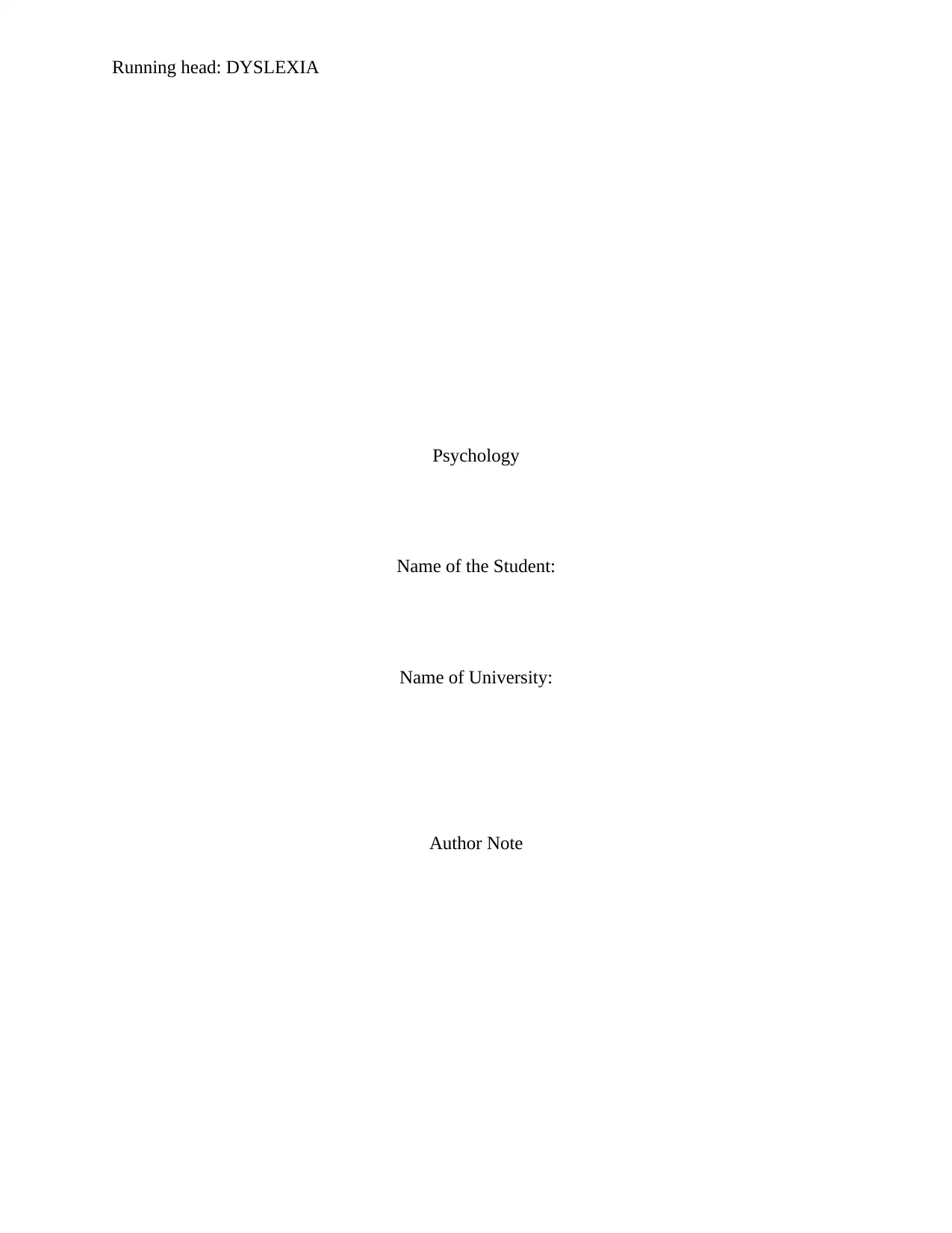
Running head: DYSLEXIA
Psychology
Name of the Student:
Name of University:
Author Note
Psychology
Name of the Student:
Name of University:
Author Note
Paraphrase This Document
Need a fresh take? Get an instant paraphrase of this document with our AI Paraphraser
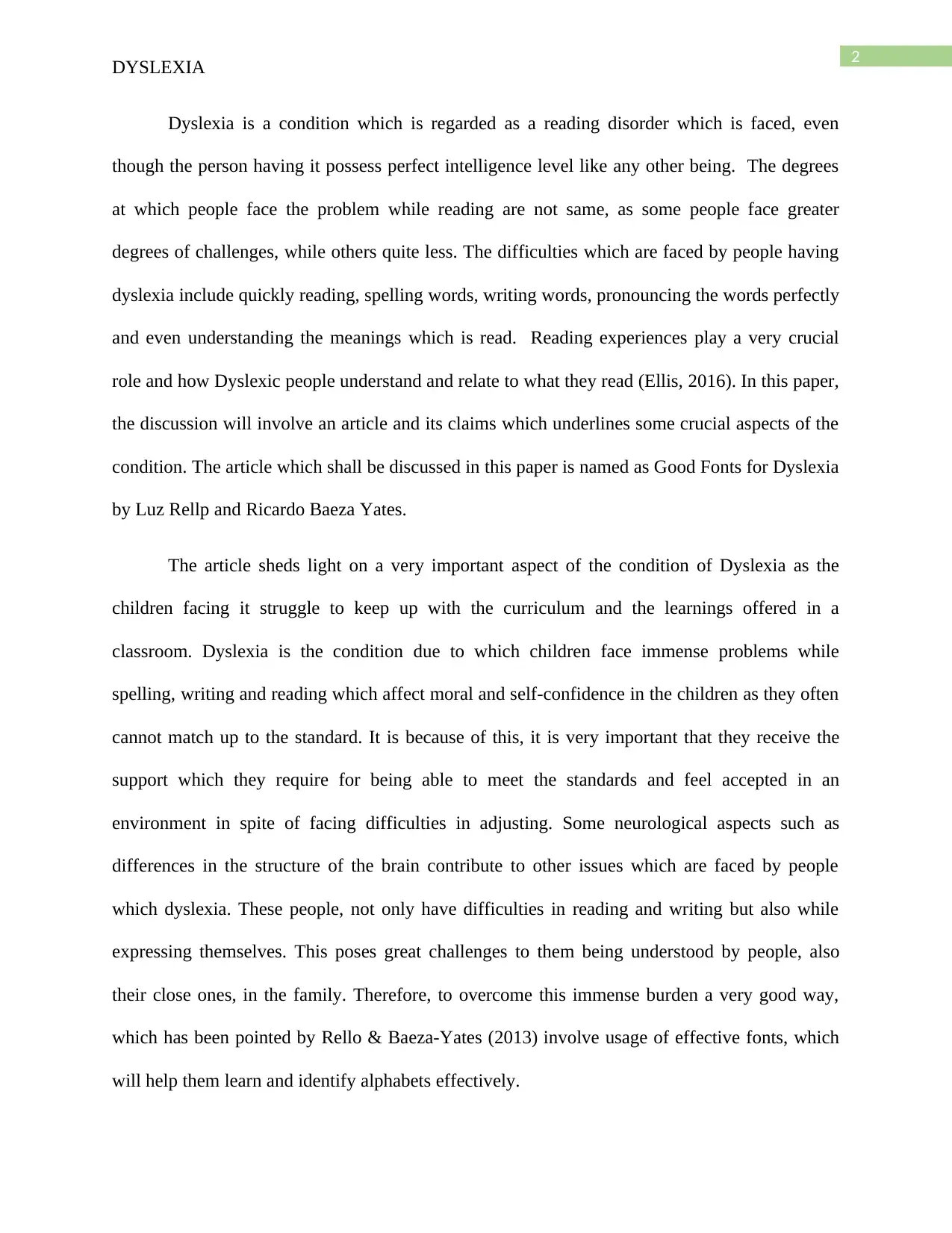
2
DYSLEXIA
Dyslexia is a condition which is regarded as a reading disorder which is faced, even
though the person having it possess perfect intelligence level like any other being. The degrees
at which people face the problem while reading are not same, as some people face greater
degrees of challenges, while others quite less. The difficulties which are faced by people having
dyslexia include quickly reading, spelling words, writing words, pronouncing the words perfectly
and even understanding the meanings which is read. Reading experiences play a very crucial
role and how Dyslexic people understand and relate to what they read (Ellis, 2016). In this paper,
the discussion will involve an article and its claims which underlines some crucial aspects of the
condition. The article which shall be discussed in this paper is named as Good Fonts for Dyslexia
by Luz Rellp and Ricardo Baeza Yates.
The article sheds light on a very important aspect of the condition of Dyslexia as the
children facing it struggle to keep up with the curriculum and the learnings offered in a
classroom. Dyslexia is the condition due to which children face immense problems while
spelling, writing and reading which affect moral and self-confidence in the children as they often
cannot match up to the standard. It is because of this, it is very important that they receive the
support which they require for being able to meet the standards and feel accepted in an
environment in spite of facing difficulties in adjusting. Some neurological aspects such as
differences in the structure of the brain contribute to other issues which are faced by people
which dyslexia. These people, not only have difficulties in reading and writing but also while
expressing themselves. This poses great challenges to them being understood by people, also
their close ones, in the family. Therefore, to overcome this immense burden a very good way,
which has been pointed by Rello & Baeza-Yates (2013) involve usage of effective fonts, which
will help them learn and identify alphabets effectively.
DYSLEXIA
Dyslexia is a condition which is regarded as a reading disorder which is faced, even
though the person having it possess perfect intelligence level like any other being. The degrees
at which people face the problem while reading are not same, as some people face greater
degrees of challenges, while others quite less. The difficulties which are faced by people having
dyslexia include quickly reading, spelling words, writing words, pronouncing the words perfectly
and even understanding the meanings which is read. Reading experiences play a very crucial
role and how Dyslexic people understand and relate to what they read (Ellis, 2016). In this paper,
the discussion will involve an article and its claims which underlines some crucial aspects of the
condition. The article which shall be discussed in this paper is named as Good Fonts for Dyslexia
by Luz Rellp and Ricardo Baeza Yates.
The article sheds light on a very important aspect of the condition of Dyslexia as the
children facing it struggle to keep up with the curriculum and the learnings offered in a
classroom. Dyslexia is the condition due to which children face immense problems while
spelling, writing and reading which affect moral and self-confidence in the children as they often
cannot match up to the standard. It is because of this, it is very important that they receive the
support which they require for being able to meet the standards and feel accepted in an
environment in spite of facing difficulties in adjusting. Some neurological aspects such as
differences in the structure of the brain contribute to other issues which are faced by people
which dyslexia. These people, not only have difficulties in reading and writing but also while
expressing themselves. This poses great challenges to them being understood by people, also
their close ones, in the family. Therefore, to overcome this immense burden a very good way,
which has been pointed by Rello & Baeza-Yates (2013) involve usage of effective fonts, which
will help them learn and identify alphabets effectively.
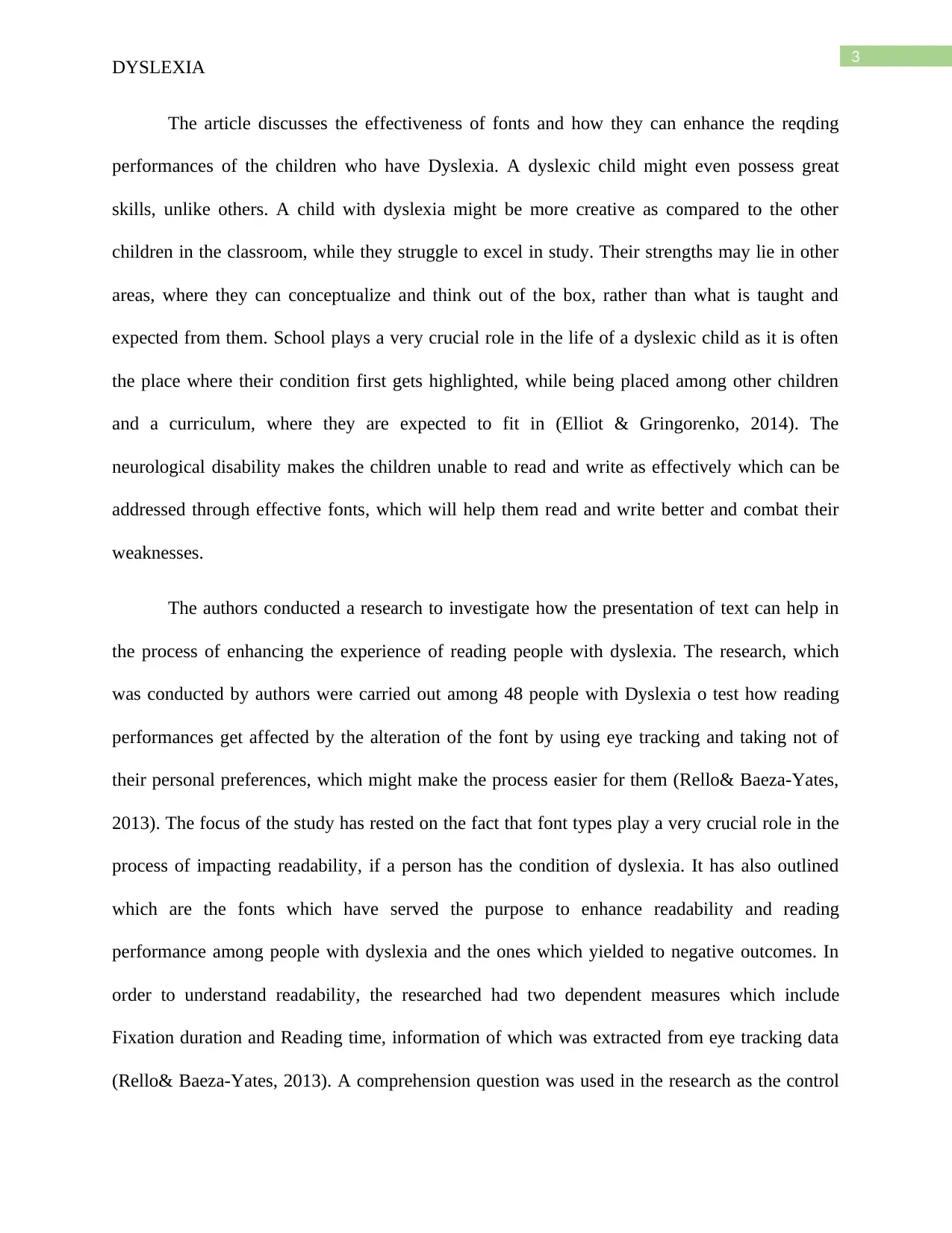
3
DYSLEXIA
The article discusses the effectiveness of fonts and how they can enhance the reqding
performances of the children who have Dyslexia. A dyslexic child might even possess great
skills, unlike others. A child with dyslexia might be more creative as compared to the other
children in the classroom, while they struggle to excel in study. Their strengths may lie in other
areas, where they can conceptualize and think out of the box, rather than what is taught and
expected from them. School plays a very crucial role in the life of a dyslexic child as it is often
the place where their condition first gets highlighted, while being placed among other children
and a curriculum, where they are expected to fit in (Elliot & Gringorenko, 2014). The
neurological disability makes the children unable to read and write as effectively which can be
addressed through effective fonts, which will help them read and write better and combat their
weaknesses.
The authors conducted a research to investigate how the presentation of text can help in
the process of enhancing the experience of reading people with dyslexia. The research, which
was conducted by authors were carried out among 48 people with Dyslexia o test how reading
performances get affected by the alteration of the font by using eye tracking and taking not of
their personal preferences, which might make the process easier for them (Rello& Baeza-Yates,
2013). The focus of the study has rested on the fact that font types play a very crucial role in the
process of impacting readability, if a person has the condition of dyslexia. It has also outlined
which are the fonts which have served the purpose to enhance readability and reading
performance among people with dyslexia and the ones which yielded to negative outcomes. In
order to understand readability, the researched had two dependent measures which include
Fixation duration and Reading time, information of which was extracted from eye tracking data
(Rello& Baeza-Yates, 2013). A comprehension question was used in the research as the control
DYSLEXIA
The article discusses the effectiveness of fonts and how they can enhance the reqding
performances of the children who have Dyslexia. A dyslexic child might even possess great
skills, unlike others. A child with dyslexia might be more creative as compared to the other
children in the classroom, while they struggle to excel in study. Their strengths may lie in other
areas, where they can conceptualize and think out of the box, rather than what is taught and
expected from them. School plays a very crucial role in the life of a dyslexic child as it is often
the place where their condition first gets highlighted, while being placed among other children
and a curriculum, where they are expected to fit in (Elliot & Gringorenko, 2014). The
neurological disability makes the children unable to read and write as effectively which can be
addressed through effective fonts, which will help them read and write better and combat their
weaknesses.
The authors conducted a research to investigate how the presentation of text can help in
the process of enhancing the experience of reading people with dyslexia. The research, which
was conducted by authors were carried out among 48 people with Dyslexia o test how reading
performances get affected by the alteration of the font by using eye tracking and taking not of
their personal preferences, which might make the process easier for them (Rello& Baeza-Yates,
2013). The focus of the study has rested on the fact that font types play a very crucial role in the
process of impacting readability, if a person has the condition of dyslexia. It has also outlined
which are the fonts which have served the purpose to enhance readability and reading
performance among people with dyslexia and the ones which yielded to negative outcomes. In
order to understand readability, the researched had two dependent measures which include
Fixation duration and Reading time, information of which was extracted from eye tracking data
(Rello& Baeza-Yates, 2013). A comprehension question was used in the research as the control
⊘ This is a preview!⊘
Do you want full access?
Subscribe today to unlock all pages.

Trusted by 1+ million students worldwide
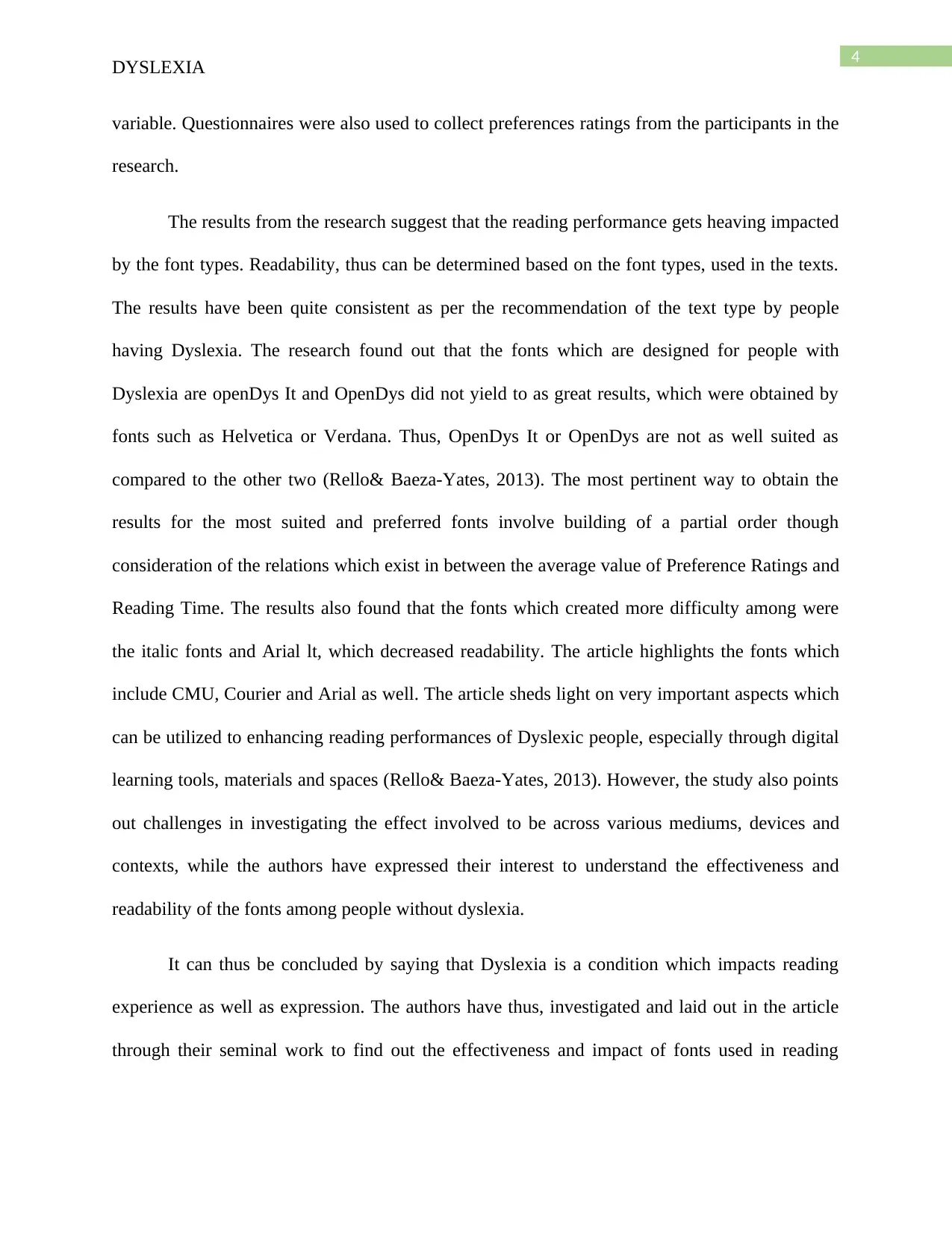
4
DYSLEXIA
variable. Questionnaires were also used to collect preferences ratings from the participants in the
research.
The results from the research suggest that the reading performance gets heaving impacted
by the font types. Readability, thus can be determined based on the font types, used in the texts.
The results have been quite consistent as per the recommendation of the text type by people
having Dyslexia. The research found out that the fonts which are designed for people with
Dyslexia are openDys It and OpenDys did not yield to as great results, which were obtained by
fonts such as Helvetica or Verdana. Thus, OpenDys It or OpenDys are not as well suited as
compared to the other two (Rello& Baeza-Yates, 2013). The most pertinent way to obtain the
results for the most suited and preferred fonts involve building of a partial order though
consideration of the relations which exist in between the average value of Preference Ratings and
Reading Time. The results also found that the fonts which created more difficulty among were
the italic fonts and Arial lt, which decreased readability. The article highlights the fonts which
include CMU, Courier and Arial as well. The article sheds light on very important aspects which
can be utilized to enhancing reading performances of Dyslexic people, especially through digital
learning tools, materials and spaces (Rello& Baeza-Yates, 2013). However, the study also points
out challenges in investigating the effect involved to be across various mediums, devices and
contexts, while the authors have expressed their interest to understand the effectiveness and
readability of the fonts among people without dyslexia.
It can thus be concluded by saying that Dyslexia is a condition which impacts reading
experience as well as expression. The authors have thus, investigated and laid out in the article
through their seminal work to find out the effectiveness and impact of fonts used in reading
DYSLEXIA
variable. Questionnaires were also used to collect preferences ratings from the participants in the
research.
The results from the research suggest that the reading performance gets heaving impacted
by the font types. Readability, thus can be determined based on the font types, used in the texts.
The results have been quite consistent as per the recommendation of the text type by people
having Dyslexia. The research found out that the fonts which are designed for people with
Dyslexia are openDys It and OpenDys did not yield to as great results, which were obtained by
fonts such as Helvetica or Verdana. Thus, OpenDys It or OpenDys are not as well suited as
compared to the other two (Rello& Baeza-Yates, 2013). The most pertinent way to obtain the
results for the most suited and preferred fonts involve building of a partial order though
consideration of the relations which exist in between the average value of Preference Ratings and
Reading Time. The results also found that the fonts which created more difficulty among were
the italic fonts and Arial lt, which decreased readability. The article highlights the fonts which
include CMU, Courier and Arial as well. The article sheds light on very important aspects which
can be utilized to enhancing reading performances of Dyslexic people, especially through digital
learning tools, materials and spaces (Rello& Baeza-Yates, 2013). However, the study also points
out challenges in investigating the effect involved to be across various mediums, devices and
contexts, while the authors have expressed their interest to understand the effectiveness and
readability of the fonts among people without dyslexia.
It can thus be concluded by saying that Dyslexia is a condition which impacts reading
experience as well as expression. The authors have thus, investigated and laid out in the article
through their seminal work to find out the effectiveness and impact of fonts used in reading
Paraphrase This Document
Need a fresh take? Get an instant paraphrase of this document with our AI Paraphraser
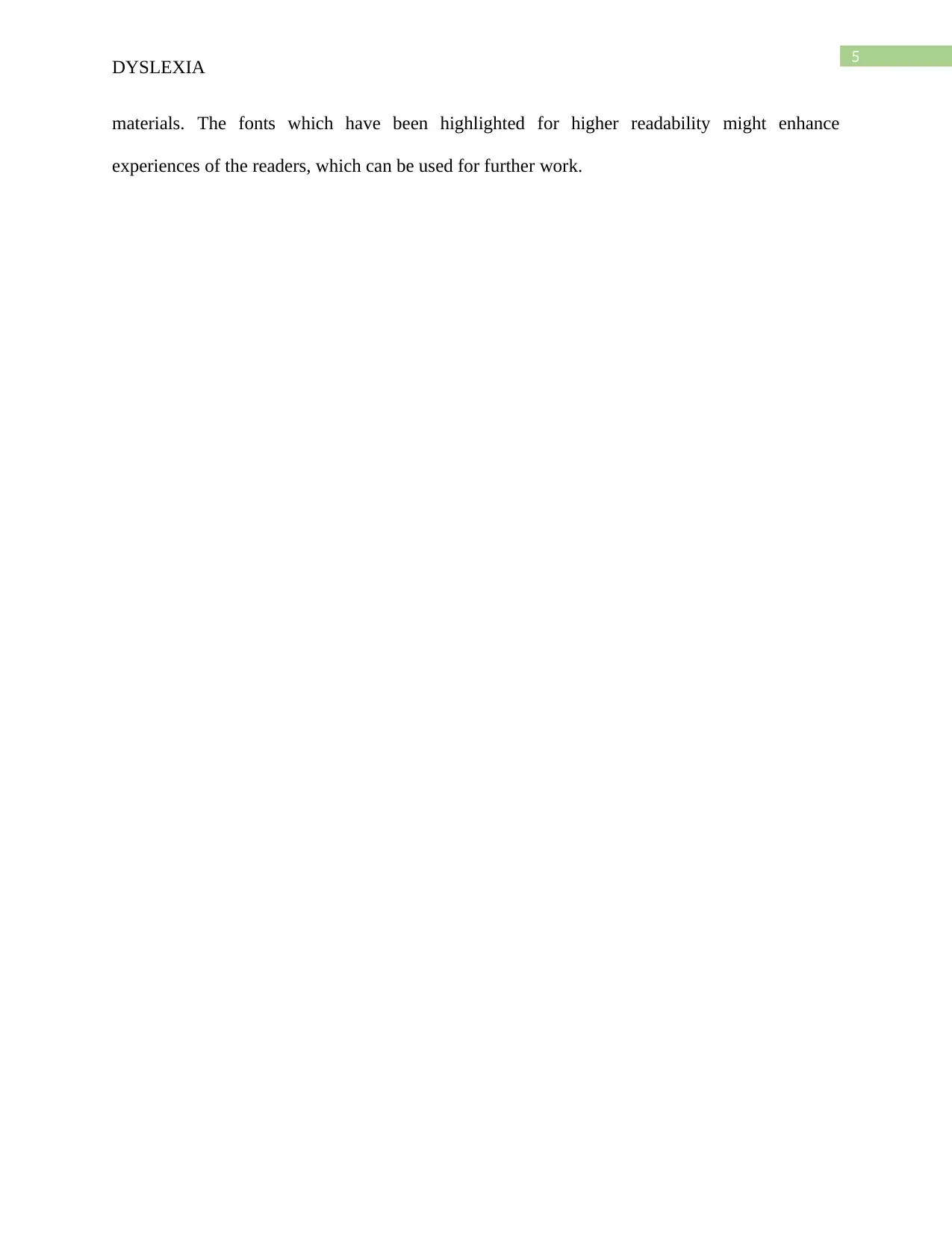
5
DYSLEXIA
materials. The fonts which have been highlighted for higher readability might enhance
experiences of the readers, which can be used for further work.
DYSLEXIA
materials. The fonts which have been highlighted for higher readability might enhance
experiences of the readers, which can be used for further work.
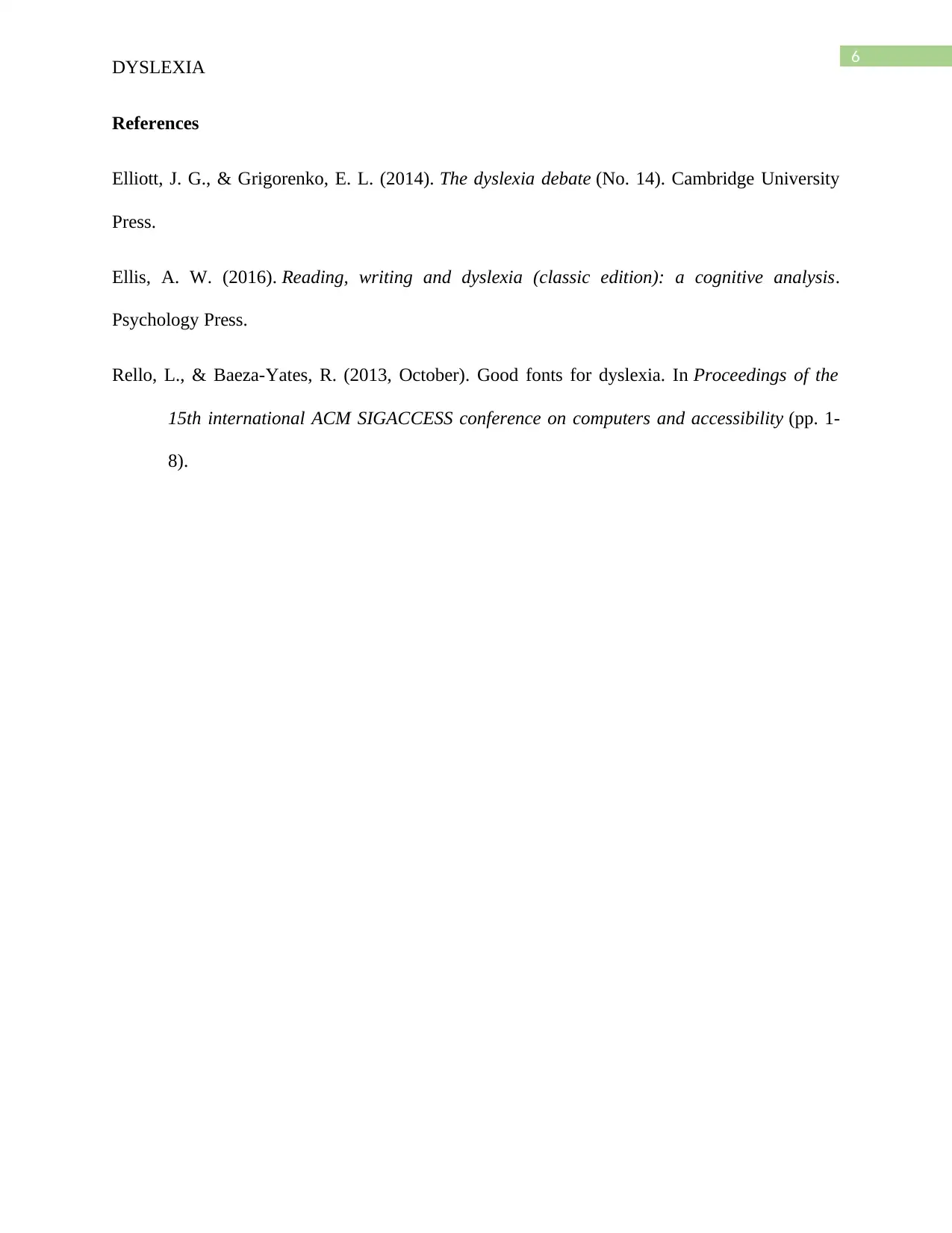
6
DYSLEXIA
References
Elliott, J. G., & Grigorenko, E. L. (2014). The dyslexia debate (No. 14). Cambridge University
Press.
Ellis, A. W. (2016). Reading, writing and dyslexia (classic edition): a cognitive analysis.
Psychology Press.
Rello, L., & Baeza-Yates, R. (2013, October). Good fonts for dyslexia. In Proceedings of the
15th international ACM SIGACCESS conference on computers and accessibility (pp. 1-
8).
DYSLEXIA
References
Elliott, J. G., & Grigorenko, E. L. (2014). The dyslexia debate (No. 14). Cambridge University
Press.
Ellis, A. W. (2016). Reading, writing and dyslexia (classic edition): a cognitive analysis.
Psychology Press.
Rello, L., & Baeza-Yates, R. (2013, October). Good fonts for dyslexia. In Proceedings of the
15th international ACM SIGACCESS conference on computers and accessibility (pp. 1-
8).
⊘ This is a preview!⊘
Do you want full access?
Subscribe today to unlock all pages.

Trusted by 1+ million students worldwide
1 out of 6
Related Documents
Your All-in-One AI-Powered Toolkit for Academic Success.
+13062052269
info@desklib.com
Available 24*7 on WhatsApp / Email
![[object Object]](/_next/static/media/star-bottom.7253800d.svg)
Unlock your academic potential
Copyright © 2020–2025 A2Z Services. All Rights Reserved. Developed and managed by ZUCOL.




